Choosing the right platform to sell products online can feel overwhelming, especially when you want to sell digital items. With so many options available, you might come across Sellfy vs Shopify, two popular choices in the market. Both platforms help e-merchants build their online stores effortlessly, but they do it in different ways.
In this article, we'll walk you through the key differences between Sellfy vs Shopify across the following criteria:
- Pricing
- Ease of use
- eCommerce features
- Marketing and SEO
- Design and customization
- Apps and integrations
- Customer support
- Security
We hope that by the end of this article, you’ll have a clear idea of which platform works best for your needs. Let’s get started!
An Overview of Sellfy and Shopify
Before we dive into a detailed comparison, it’s important to understand what Sellfy vs Shopify are and who they are built for. While both platforms help users sell products online, they offer different tools, pricing, and experiences.
Firstly, let's discuss Sellfy, a cloud-based eCommerce platform built especially for creators selling digital products, physical goods, subscriptions, and print-on-demand merchandise. This platform focuses on simplicity and speed, making it a favorite among artists, writers, musicians, and online influencers who want to start selling without dealing with a complex setup.
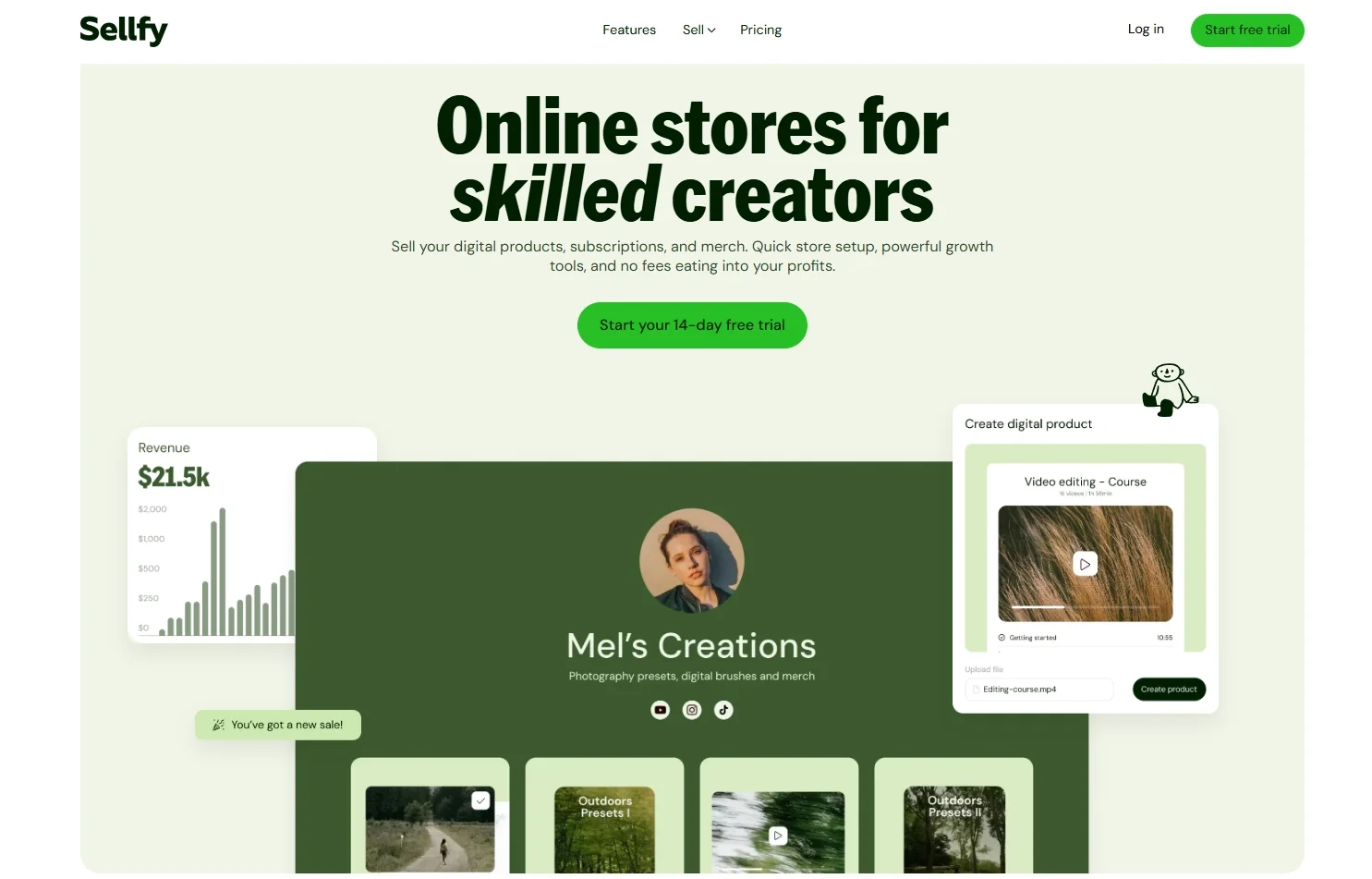
Sellfy lets users launch a fully functional online store in just a few minutes. You don’t need any coding skills or design experience to get started. Everything you need, like product pages, checkout, file delivery, and even email marketing, is already built in. This makes it ideal for individuals or small teams who want an all-in-one tool that works right out of the box. Nonetheless, please note that this platform might not be as flexible as its counterparts in the Sellfy vs Shopify comparison.
Here’s a quick breakdown of Sellfy’s main pros and cons:
Pros | Cons |
✓ Easy to set up and use, even for complete beginners ✓ Built specifically for digital product sales and content creators ✓ Fast digital file delivery and secure hosting ✓ No transaction fee | ✗ Limited design customization compared to Shopify ✗ Smaller app and integration ecosystem ✗ Basic eCommerce features only, not ideal for complex or large business ✗ Limited payment gateway options |
Next, let's take a look at Shopify, one of the best eCommerce platforms on the market. It allows users to build fully functional online stores where they can sell both physical and digital products. With Shopify, you can manage your entire business in one place, from adding products and setting prices to handling payments, shipping, and marketing.

What we like best about Shopify is that it's extremely flexible and scalable, especially for users who plan to grow their business over time. The platform supports a wide range of industries and offers a deep set of tools to help sellers succeed. Whether you're selling handmade goods, clothing, software, or subscriptions, Shopify features have everything you need. However, we also recognize that Shopify comes with a steeper learning curve and can feel overwhelming for beginners who prefer a simpler setup.
To help you better understand if Shopify is the right fit for you, here is a table outlining the main pros and cons of the platform:
Pros | Cons |
✓ Offers advanced features for both physical and digital sales ✓ Supports multichannel selling (social media, POS, etc.) ✓ Large app marketplace with thousands of extensions ✓ Highly customizable with professional themes and templates ✓ Built-in tools for SEO, email marketing, and automation | ✗ Can be complex for users who are just getting started ✗ Paid themes and third-party apps can quickly add up to your cost ✗ Customization often requires coding knowledge or hiring developers ✗ High transaction fee if not using Shopify Payments |
For more expert insights on this platform, please don't forget to check out our in-depth Shopify review.
Sellfy vs Shopify – A Quick Comparison
Now that we've fully understood what each platform is made for, you're already one step closer to choosing the right one. In this section, we'll give you a quick side-by-side comparison of Sellfy vs Shopify for a clear picture of how these platforms stack up.
Feature | Sellfy | Shopify | The Winner |
Pricing | $29-$159/month No transaction fee | $39-$2,300+/month Transaction fee required | Sellfy |
Ease of Use | Very simple, beginner-friendly with no technical skill required | Also beginner-friendly but has a steeper learning curve | Sellfy |
Digital Product Selling | Built specifically for digital products | Supports digital sales but requires add-ons | Sellfy |
Sales Channels | Limited (storefront, buy buttons) | Multichannel (storefront, social, POS,...) | Shopify |
Payment Gateways | Stripe and PayPal | Supports 100+ options | Shopify |
SEO & Marketing | Built-in email marketing, basic SEO functions | Diverse marketing and SEO tools | Shopify |
Design & Customization | Limited themes and custom control | Wide theme library and custom code access | Shopify |
Apps & Integrations | Limited integrations | Thousands of third-party apps available | Shopify |
Customer Support | Email support, help center | Email support, help center, community | Shopify |
Security | SSL, PCI-DSS, secure file delivery | SSL, PCI-DSS, strong fraud prevention | A Tie |
Based on the comparison above, we believe Sellfy will be the better solution if you:
- Are a digital creator, such as an artist, author, musician, or YouTuber
- Want to sell digital products, subscriptions, or print-on-demand
- Prefer a simple, no-fuss setup with everything built-in
- Are working solo or in a small team with minimal technical knowledge
On the other hand, you should consider Shopify if you:
- Plan to scale a business or manage a larger product catalog
- Want to sell both physical and digital products across multiple channels
- Need more control over design, layout, and features
- Require integrations with marketing, shipping, and inventory tools
Up next, we’ll explore each category in this Sellfy vs Shopify in more depth, starting with pricing.
Pricing – Sellfy is More Affordable
When comparing Sellfy vs Shopify, one of the biggest differences you'll notice right away is the cost. Though both platforms use a subscription model, the amount charged monthly differs greatly.
Sellfy pricing
Sellfy offers three clear and affordable pricing plans designed to meet the needs of solo creators, small businesses, and growing brands. All plans include core eCommerce features like unlimited products, email marketing, and support for selling digital downloads, subscriptions, and physical merchandise, with no transaction fee charged. Especially, all plans come with a 14-day free trial, so you can try the platform before making a commitment.
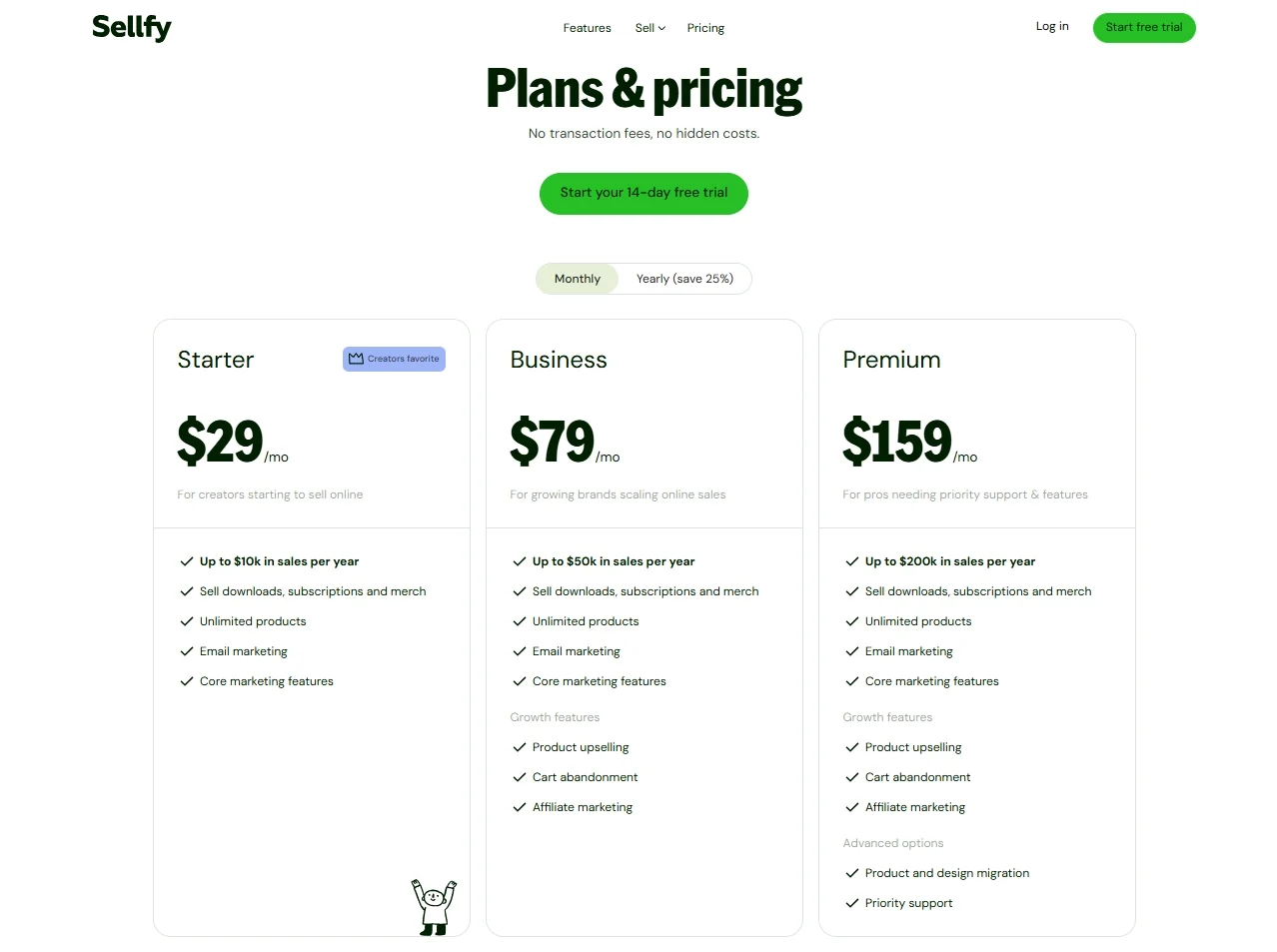
The Starter plan is priced at $22/month and is ideal for creators just beginning to sell online. It allows up to $10,000 in sales per year and includes everything needed to launch a store, such as product uploads, basic marketing tools, and email campaigns.
Next is the Business plan at $59/month, which supports up to $50,000 in annual sales. This plan includes all the features from Starter and adds more advanced tools to help increase conversions. These include product upselling, cart abandonment recovery, and affiliate marketing, making it suitable for brands looking to scale.
The highest tier, Premium, is available at $119/month and is geared toward professionals or high-volume sellers. It allows up to $200,000 in sales per year and includes everything in the Business plan, along with product and design migration services and priority support. This plan is best for users who want white-glove onboarding and faster access to customer service.
Overall, Sellfy’s pricing is simple, transparent, and built with digital creators in mind. We think it's a great option for anyone looking to run a professional online store without dealing with hidden fees or complicated billing structures.
Shopify pricing
On the other side, Shopify pricing comes with four different tiers designed to support everyone from solo entrepreneurs to large enterprise businesses. While the platform is powerful and feature-rich, its cost structure can become more complex and expensive, depending on your needs, especially as your store scales. Shopify charges a base subscription fee, plus additional costs based on payment processing and third-party app usage.
Fortunately, all plans come with a $1/month introductory offer for the first 3 months when billed annually, making it easier to test the platform with minimal risk.
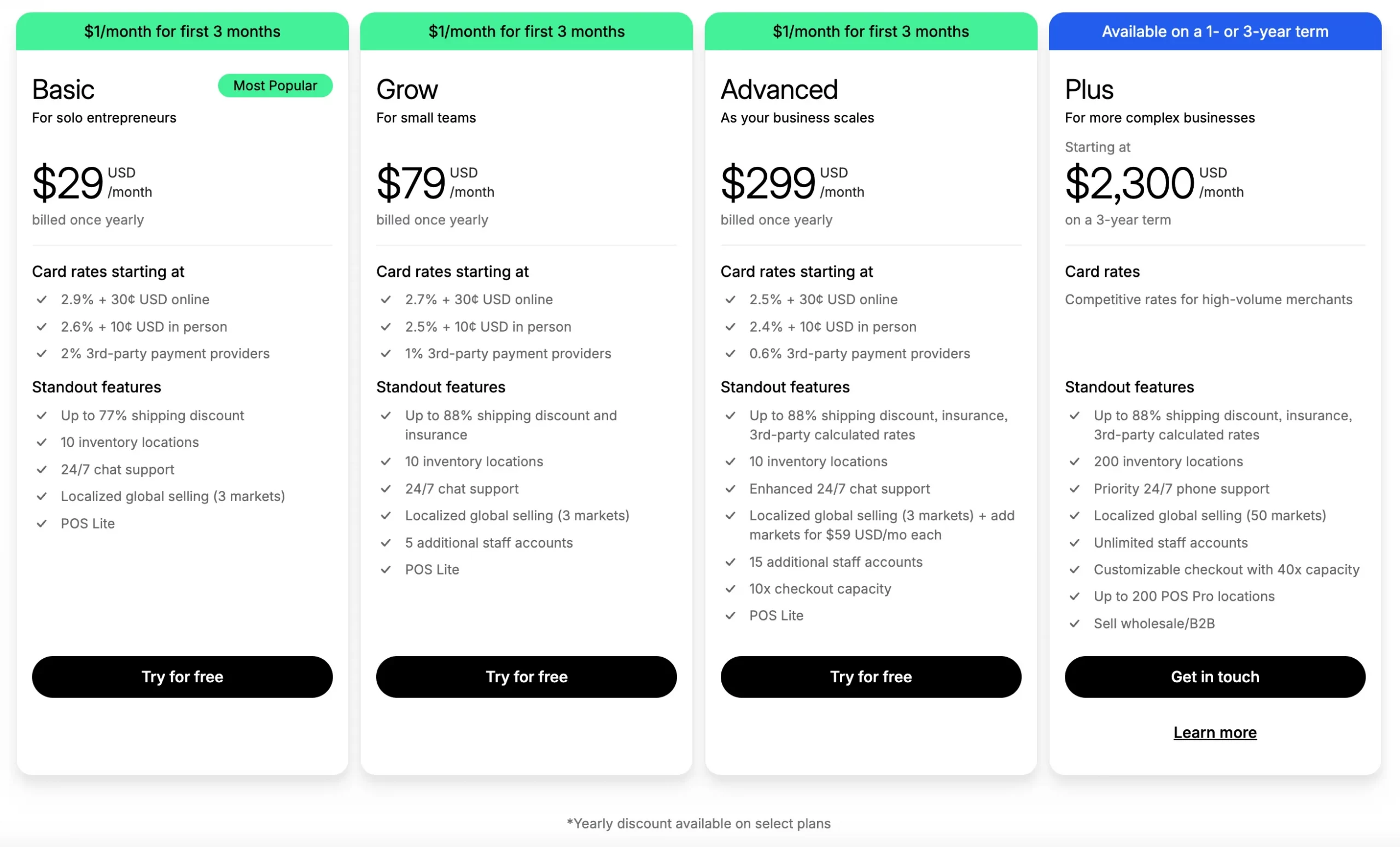
The Basic plan starts at $29/month (billed yearly) and is ideal for individuals just starting out. It includes up to 10 inventory locations, 24/7 chat support, and shipping discounts up to 77%. Online card rates start at 2.9% + 30¢, and using third-party payment providers adds a 2% fee.
The Grow plan is $79/month and adds 5 staff accounts, shipping insurance, and lower fees (2.7% + 30¢ online, 1% for third-party providers). It’s a solid option for small teams ready to scale.
The Advanced plan, at $299/month, is best for growing businesses. It includes 15 staff accounts, enhanced support, and even lower transaction fees (2.5% + 30¢ online, 0.6% third-party).
For large or complex businesses, the Shopify Plus plan, starting at $2,300/month on a 3-year term, is an option worth considering. It includes unlimited staff, 200 inventory locations, priority support, and B2B selling tools. Card rates are customized for high-volume merchants.
In summary, Shopify offers flexibility for businesses of all sizes, but it's important to budget not only for the monthly fee but also for transaction fees and optional tools you may need to operate efficiently.
➥ The verdict
When it comes to affordability between Sellfy vs Shopify, Sellfy clearly takes the lead, especially for solo creators, freelancers, and small businesses that want to keep overhead low. The platform offers transparent pricing with no hidden fees, and even the entry-level plan includes core features like digital product support, discount codes, and email marketing.
Ease of Use – Sellfy Wins
Sellfy ease of use
Sellfy makes launching an online store incredibly simple, even for users with no technical background. Its platform is designed with creators in mind, offering a clean and user-friendly dashboard that walks you through every step of the setup process. From creating your storefront to uploading products and enabling payment options, everything can be done in just a few clicks.
What impressed us the most is that Sellfy's interface is truly intuitive and uncluttered, with no complicated configurations required. All the essential tools, like product management, digital file delivery, email marketing, and discount codes, are already built into the platform. This all-in-one approach eliminates the need to connect multiple services or worry about compatibility issues.
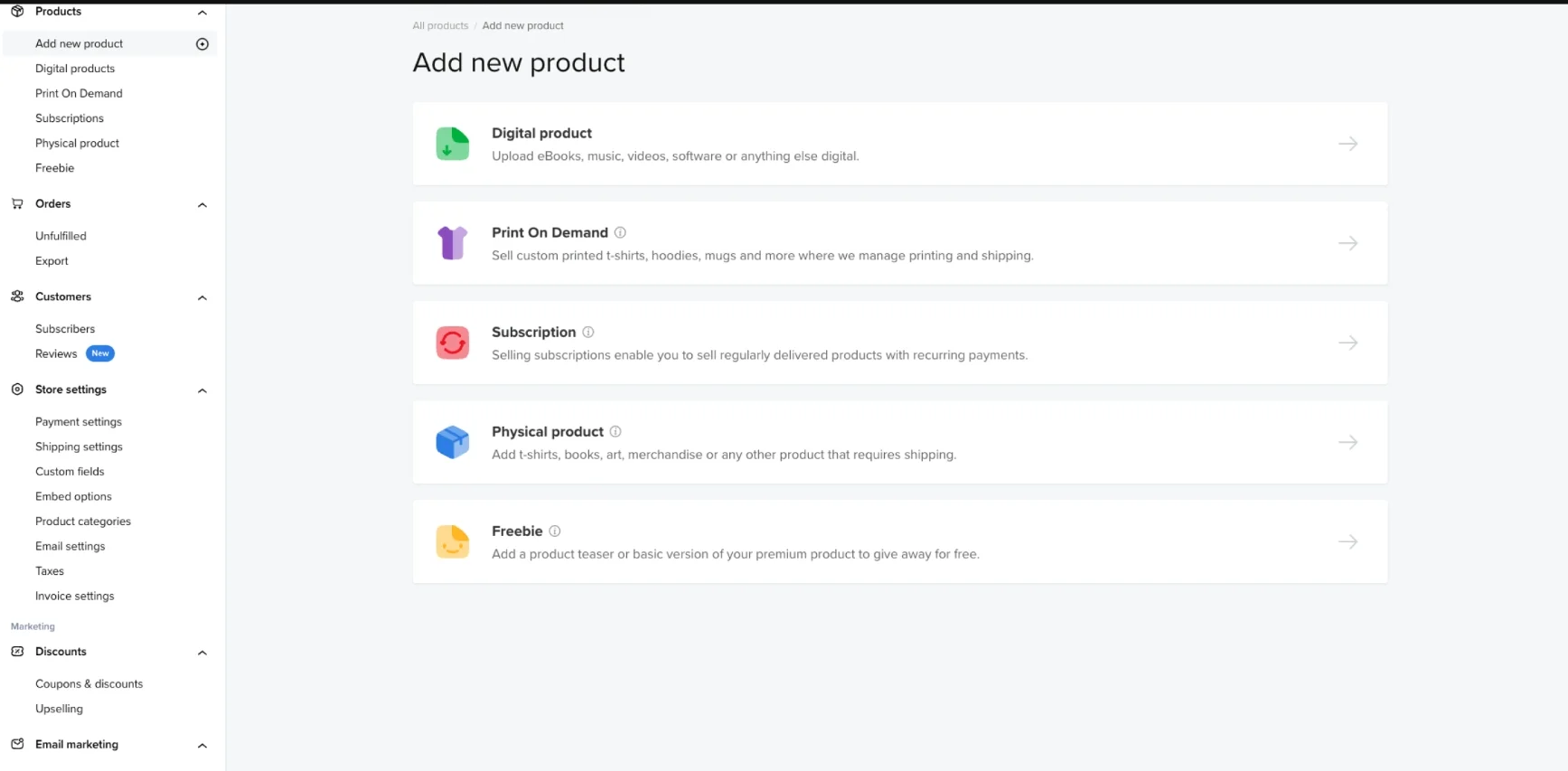
We especially appreciate how Sellfy focuses on removing friction for first-time sellers. There’s no learning curve, no coding, and no need to hire a designer or developer. If your goal is to sell quickly and keep things simple, Sellfy’s ease of use is one of its strongest advantages in the Sellfy vs Shopify competition.
Shopify ease of use
In the Sellfy vs Shopify comparison, Shopify offers a more powerful platform, but with that power comes a bit more complexity. While Shopify is still user-friendly overall, it requires more time and effort to set up, and can feel a bit overwhelming to new users.
The dashboard itself is feature-rich and designed for full store management, including inventory, orders, shipping, and marketing. Each section is clearly labeled, but because there are so many tools available, it can take time to understand where everything lives and how it all works together.
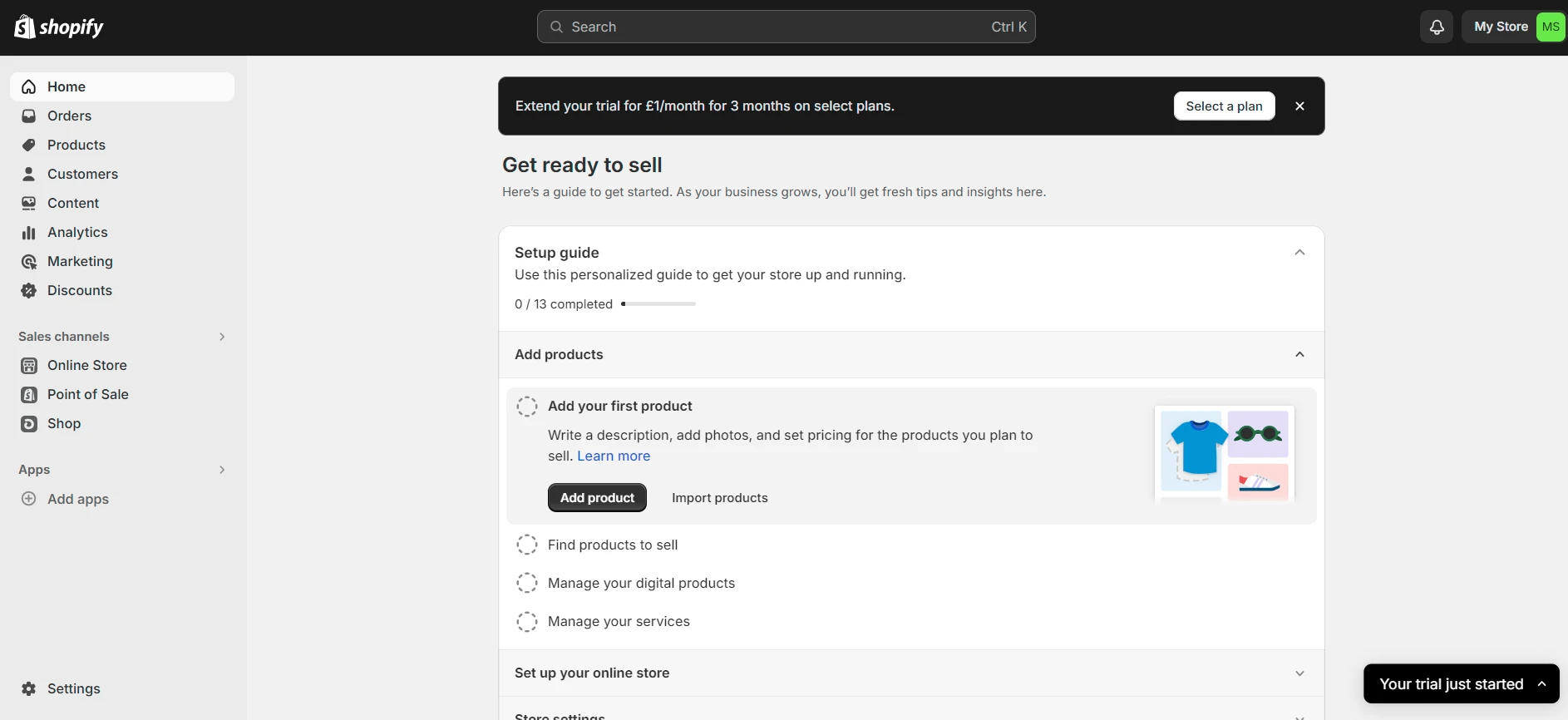
Overall, Shopify gives you more control and functionality, but at the cost of a longer setup process. Therefore, it's better suited for users who don’t mind investing time upfront to access deeper customization and business tools.
➥ The verdict
When it comes to getting started quickly and managing your store without technical stress, Sellfy clearly wins in ease of use between Sellfy vs Shopify. The platform is built with simplicity in mind, making it especially appealing for beginners, digital creators, and anyone who wants to start selling online with minimal setup.
eCommerce Features
Digital product selling – Sellfy Wins
Sellfy digital product selling capability
With Sellfy, you can upload and sell files like eBooks, music, videos, software, PDFs, and more without needing extra apps or a custom setup. The platform includes automatic file delivery, secure hosting, and download limits to help protect your content. You can also offer product variants, license keys, and even streaming for video files—all features designed for creators who sell digital goods.
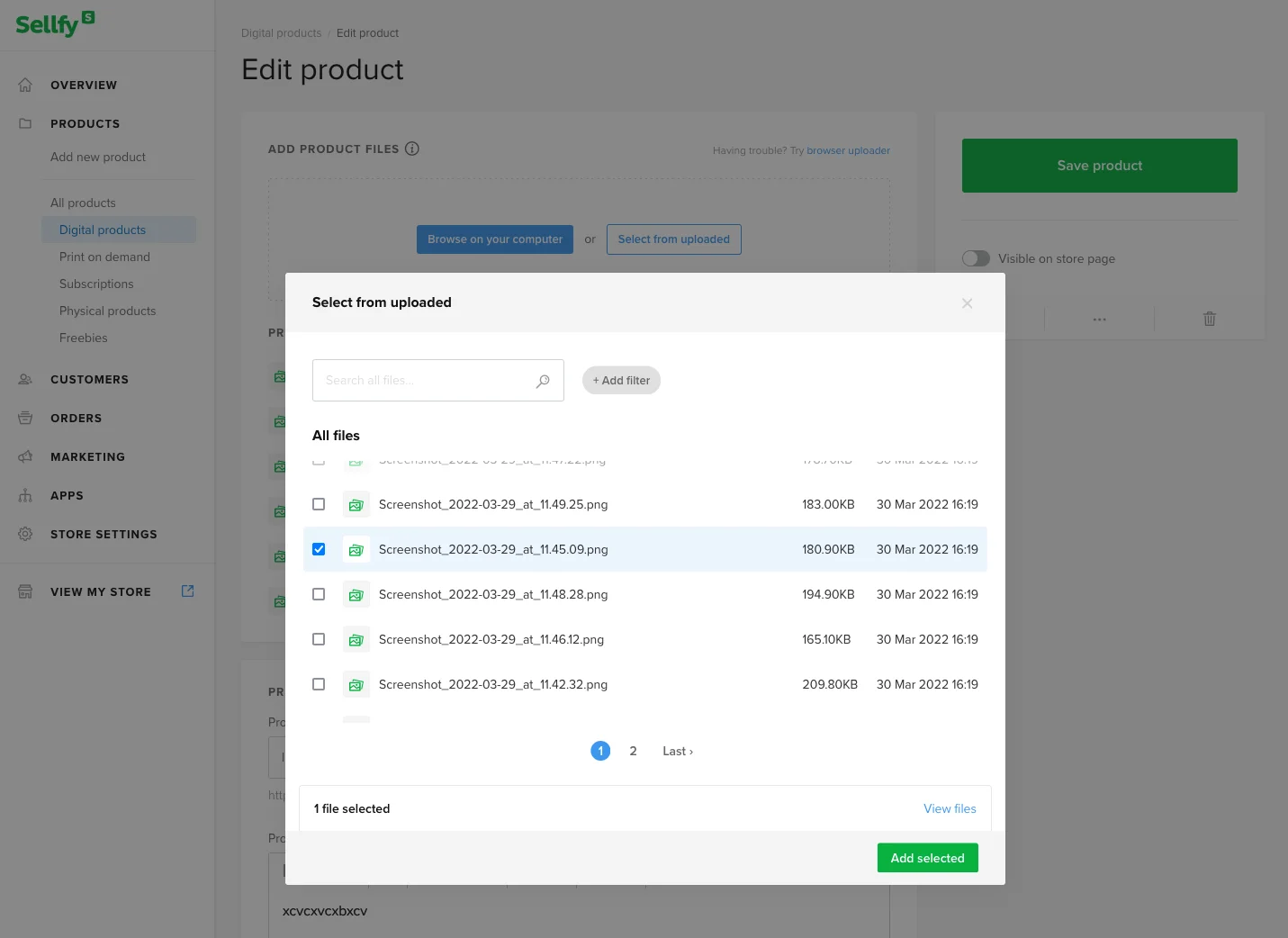
What we like most is that everything is native to Sellfy. You don’t need to install third-party tools or worry about integration issues. Whether you're selling one digital file or an entire catalog, the experience is seamless and intuitive. Sellfy also supports recurring subscriptions for digital products, making it a strong choice for creators who want to offer memberships or exclusive content.
Shopify digital product selling capability
On the other hand, Shopify does support digital product sales, but it’s not the platform’s main strength. To sell digital goods on Shopify, you’ll need to install a separate app, such as Shopify’s free Digital Downloads app. This adds functionality to deliver downloadable files to your customers after purchase.
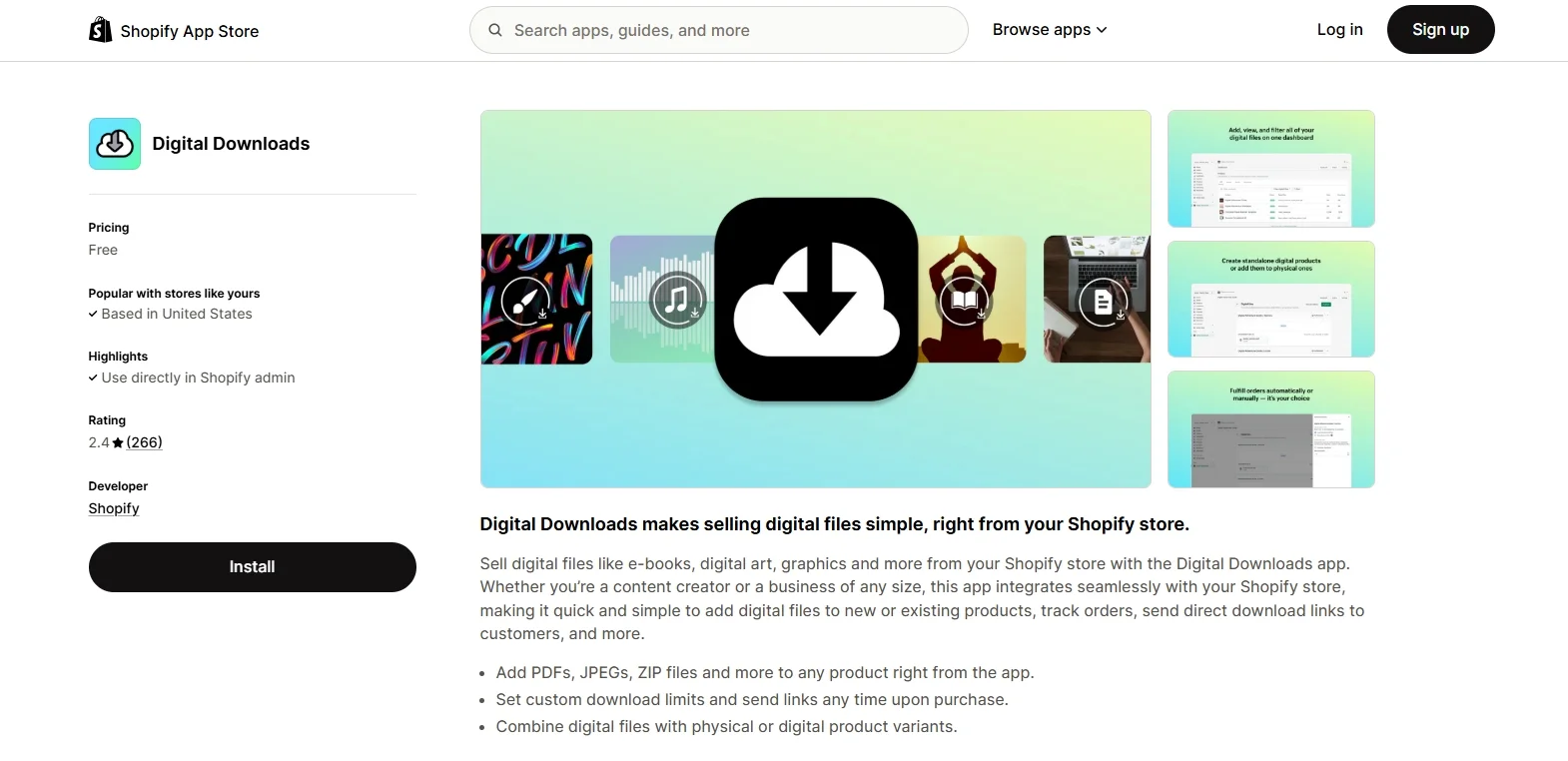
While the app works well for basic digital product delivery, it lacks the built-in depth and creator-focused features that Sellfy provides by default. For example, Shopify doesn’t include native tools for streaming video content, setting download limits, or offering license keys unless you use additional third-party apps or custom code. This means the setup process is more involved, especially for creators who want more control over how their digital products are delivered and protected.
➥ The verdict
Between Sellfy vs Shopify in selling digital products, Sellfy clearly takes the lead. While both platforms allow you to offer digital downloads, Sellfy is built specifically with creators of digital content in mind. This focus makes the entire process easier, faster, and more reliable, right out of the box.
Sales Channel – Shopify Wins
Sellfy sales channel
In the Sellfy vs Shopify comparison, Sellfy keeps things simple when it comes to sales channels. Instead of offering a wide range of integrations, Sellfy focuses on providing creators with a direct and streamlined way to sell through their own hosted storefront.
When you create a Sellfy store, you get a customizable online shop with a clean URL that you can share directly with your audience. You can also embed product links or “Buy Now” buttons on other websites, blogs, or landing pages, making it easy to convert your existing traffic into sales. This works well for creators with strong followings on YouTube, Instagram, TikTok, or personal websites.
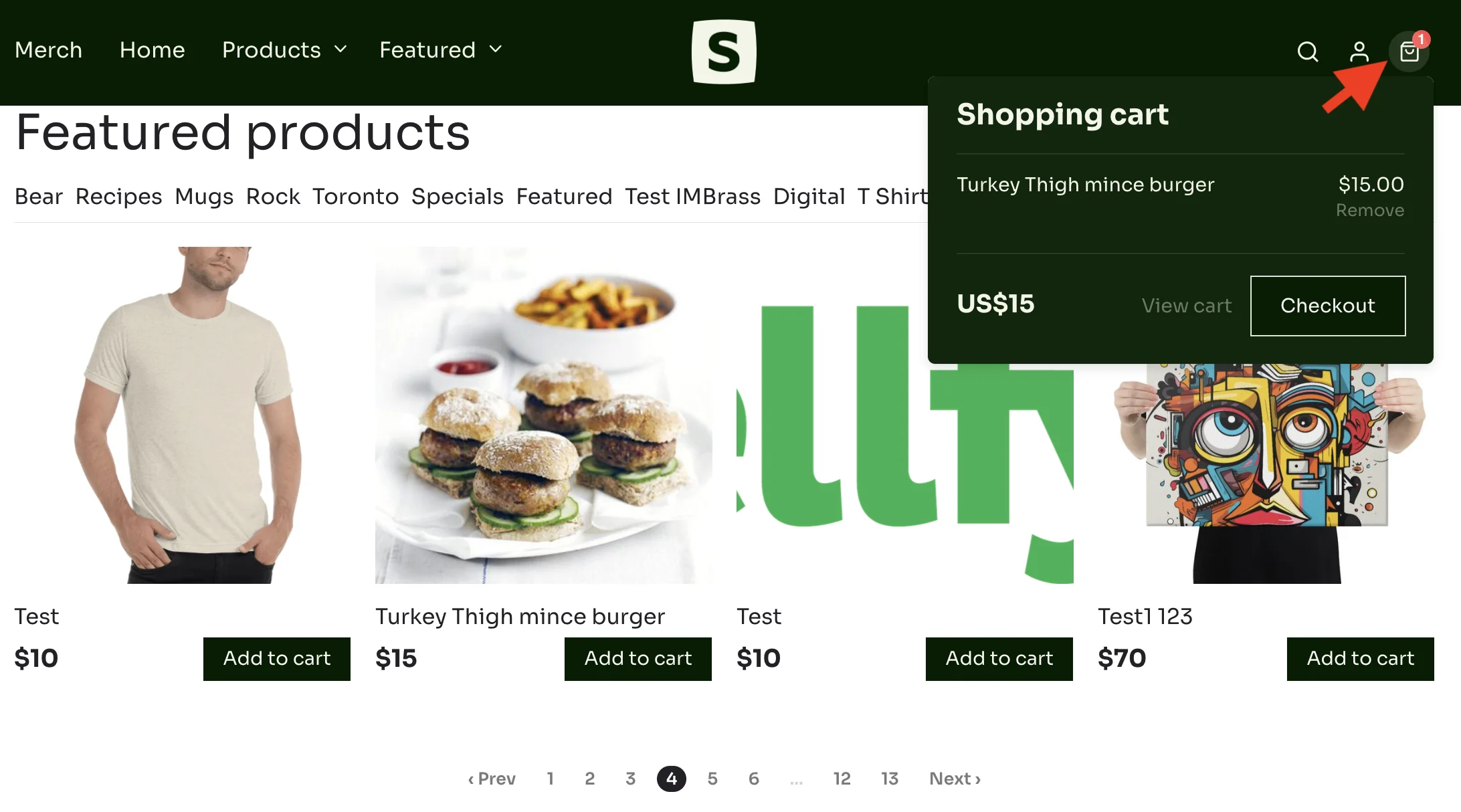
However, unlike Shopify, Sellfy does not offer native integration with third-party sales channels like Amazon, Facebook Shop, or Google Shopping. It also doesn’t include a built-in point-of-sale (POS) system for selling offline. This might be a huge disadvantage in the Sellfy vs Shopify competition, especially for e-merchants seeking a broader selling approach.
Shopify sales channel
Meanwhile, the sales channel is where Shopify clearly shines in the Sellfy vs Shopify comparison. It gives sellers the tools to reach customers across a wide variety of platforms, all from a single dashboard.
This platform comes with a house-built Shopify POS system, which is perfect for businesses that also sell at physical locations, pop-up shops, or events. You can sync inventory, manage in-person payments, and track customer data across both online and offline sales.
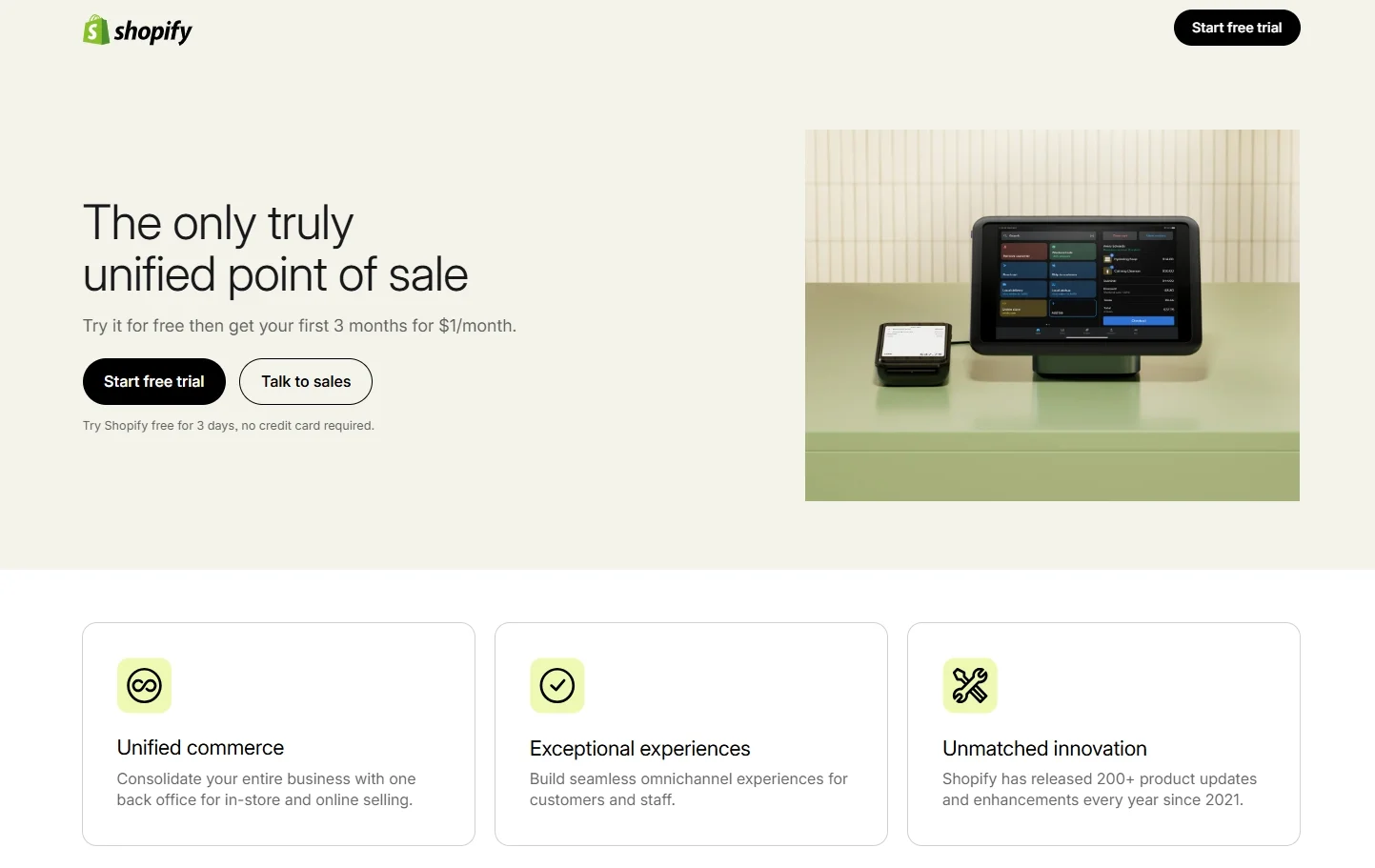
In addition, with Shopify, you can connect your store to popular social media platforms like Facebook, Instagram, TikTok, and Pinterest, allowing you to sell directly through your social content. It also integrates with major marketplaces such as Amazon, Walmart, and eBay, helping you expand your reach to a broader audience without managing separate inventories.
Another helpful feature is the Shopify Buy Button, which lets you embed products and checkout functionality into any website or blog. This is especially useful for content creators or businesses that already have a strong web presence elsewhere.
➥ The verdict
Shopify clearly comes out on top in the Sellfy vs Shopify comparison when it comes to multichannel selling. It is built for omnichannel commerce, allowing you to reach customers wherever they shop, whether it’s on your website, social media, online marketplaces, or in person.
Payment gateways – Shopify wins
Sellfy payment gateways
When looking at Sellfy vs Shopify in terms of payment options, Sellfy takes a simpler approach. The platform supports two major payment gateways: PayPal and Stripe. These options cover the essentials for most creators, allowing customers to pay using credit or debit cards, PayPal accounts, or local currency (depending on the buyer’s location).
Setting up payments in Sellfy is fast and user-friendly. You simply connect your PayPal or Stripe account through the dashboard, and you’re ready to start accepting payments. Both gateways handle secure processing and offer quick payouts, making them reliable choices for sellers.
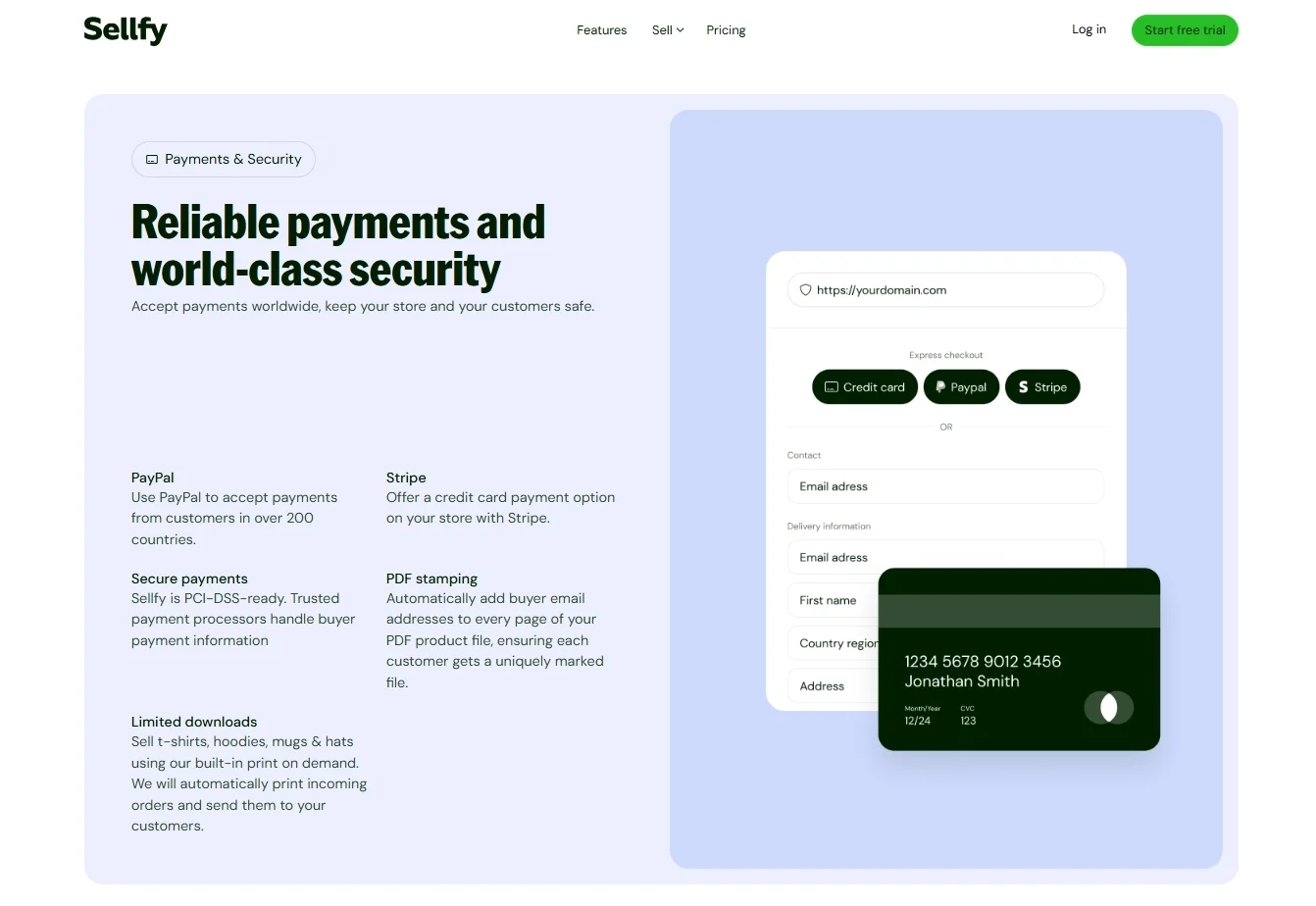
However, compared to Shopify, Sellfy’s payment options are limited. There’s no native payment processor, no support for alternative gateways like Apple Pay, Google Pay, or Amazon Pay, and fewer tools for managing fraud, chargebacks, or region-specific preferences. This could be a challenge for international sellers or businesses that need more advanced billing features.
Shopify payment gateways
In contrast, Shopify clearly stands out in terms of payment gateway options and flexibility. This platform supports over 100 payment gateways worldwide, making it ideal for both local and international sellers. This includes popular providers like PayPal, Stripe, Apple Pay, Google Pay, Amazon Pay, and many country-specific gateways tailored to different regions and currencies.
One of Shopify’s biggest advantages is its built-in processor, Shopify Payments. By using Shopify Payments, you can eliminate the extra transaction fees that normally apply when using third-party gateways. It also simplifies the payment setup process, allowing you to manage everything directly from your Shopify dashboard. It supports major credit cards, multiple currencies, accelerated checkouts, and fraud protection features, all without the need for extra apps or integrations.
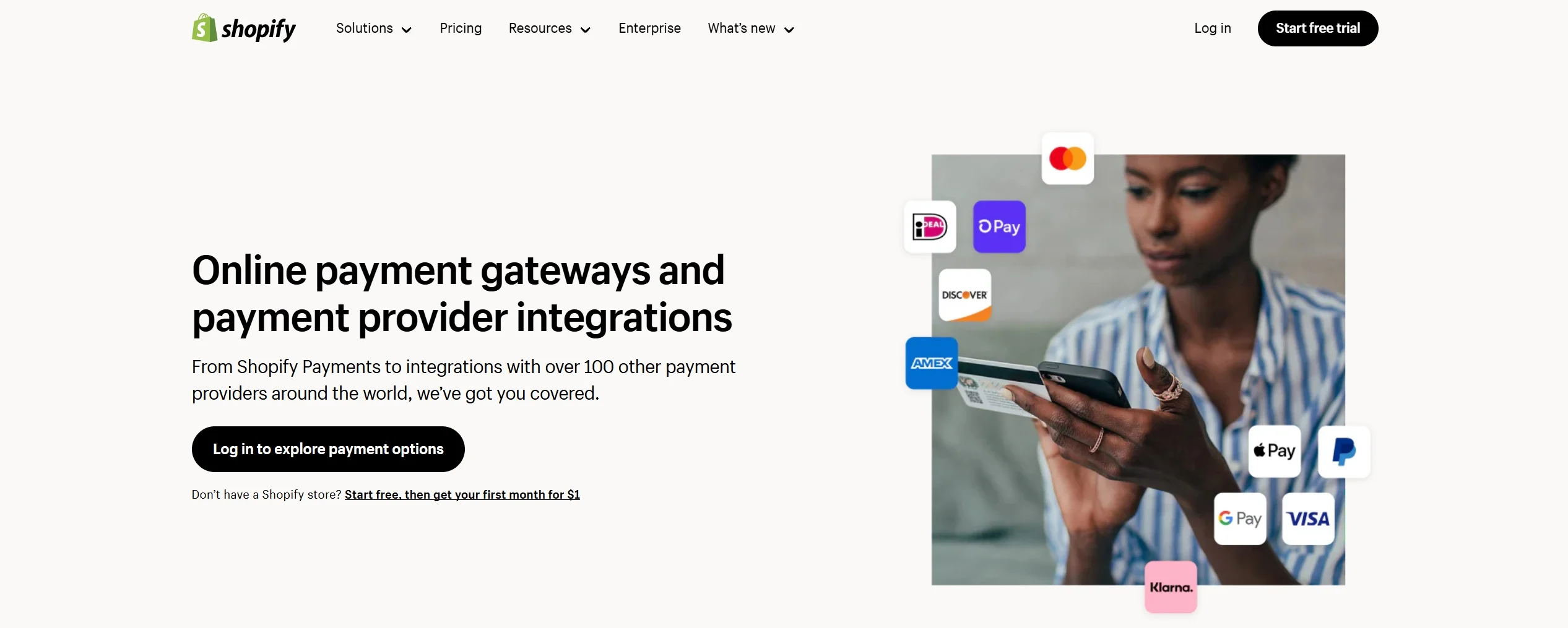
Additionally, Shopify allows you to offer buy now, pay later options (like Shop Pay Installments), manual payment methods (such as bank deposits or cash on delivery), and even custom payment gateways for more complex setups. This gives you more control over how your customers pay and helps increase conversion rates by offering convenient options at checkout.
➥ The verdict
In the Sellfy vs Shopify comparison, Shopify wins when it comes to payment gateways. It offers more flexibility, more global support, and lower fees when using its built-in payment solution. Whether you're a beginner or a growing business, Shopify gives you more control over how you accept payments from customers around the world.
Marketing and SEO – Shopify Wins
Sellfy marketing and SEO functions
In the Sellfy vs Shopify comparison, Sellfy offers a more basic set of marketing and SEO tools, focused on simplicity and ease of use. It provides essential marketing tools such as
- Email marketing: You can send email campaigns directly from your dashboard to promote new products, sales, or updates to your subscribers.
- Discount codes: Easily create fixed or percentage-based discount offers to boost conversions and reward loyal customers.
- Facebook and Twitter ad tracking: You can add ad tracking pixels to monitor campaign performance and conversions.
- Product upselling: Encourage customers to add more to their cart by promoting related products during checkout.
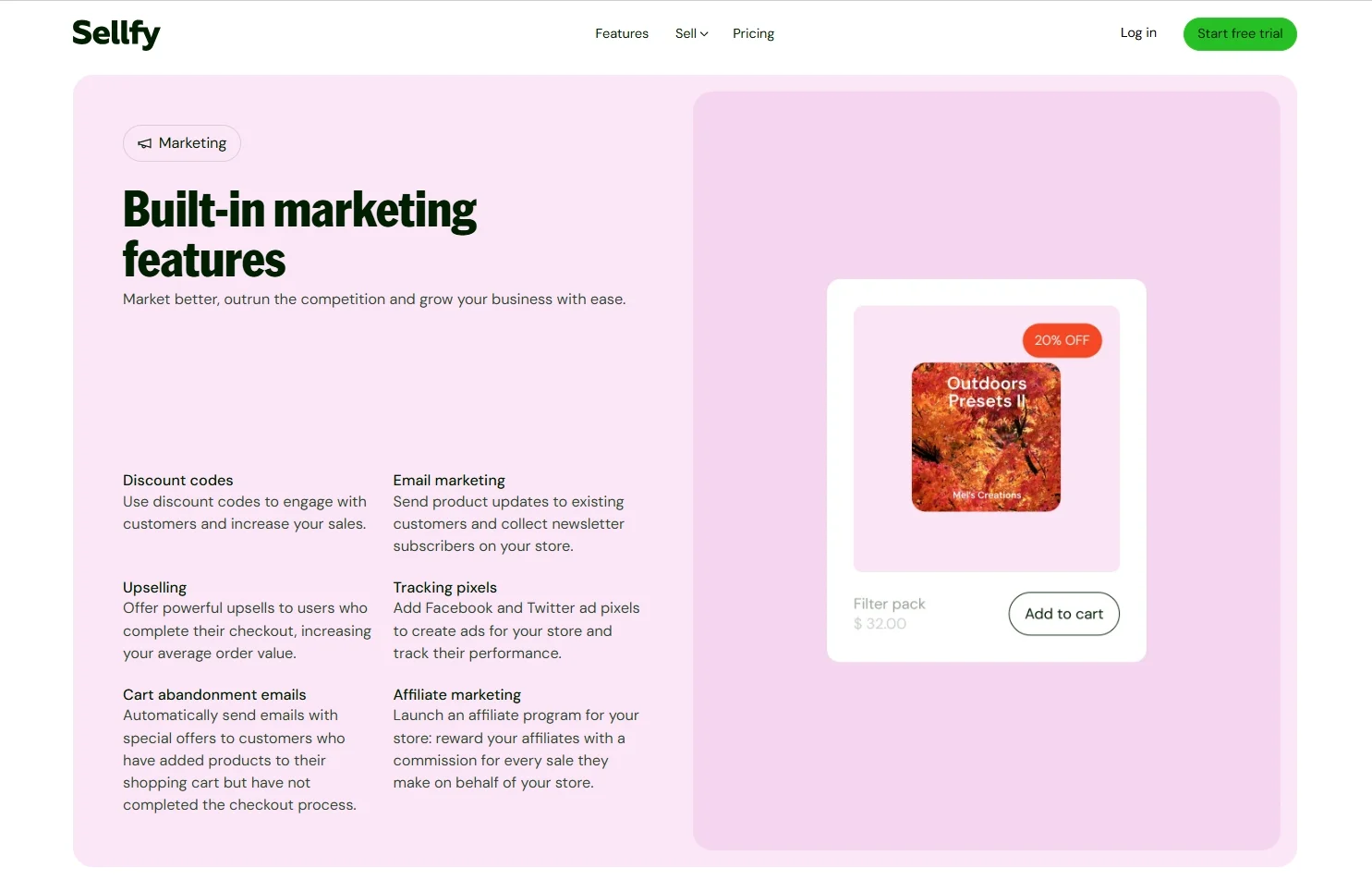
However, on the SEO side, Sellfy is quite limited. While your store and product pages are indexed by search engines, there’s no built-in blog or advanced SEO control. You can edit product titles, descriptions, and URLs, but there are fewer options to optimize meta tags, customize structured data, or create content that drives organic traffic.
Shopify marketing and SEO functions
On the other hand, Shopify offers a much broader and more powerful set of tools that help store owners attract traffic, engage customers, and improve visibility on search engines.
When it comes to marketing, Shopify provides a complete toolkit to help you run campaigns, track results, and convert visitors. Key features include:
- Abandoned cart recovery emails
- Discount codes and automatic promotions
- Integration with social media platforms like Facebook, Instagram, and TikTok for ad campaigns
- Google Ads and Google Shopping integration
- Access to a wide range of marketing and analytics apps through the Shopify App Store
- Built-in email marketing with Shopify Email
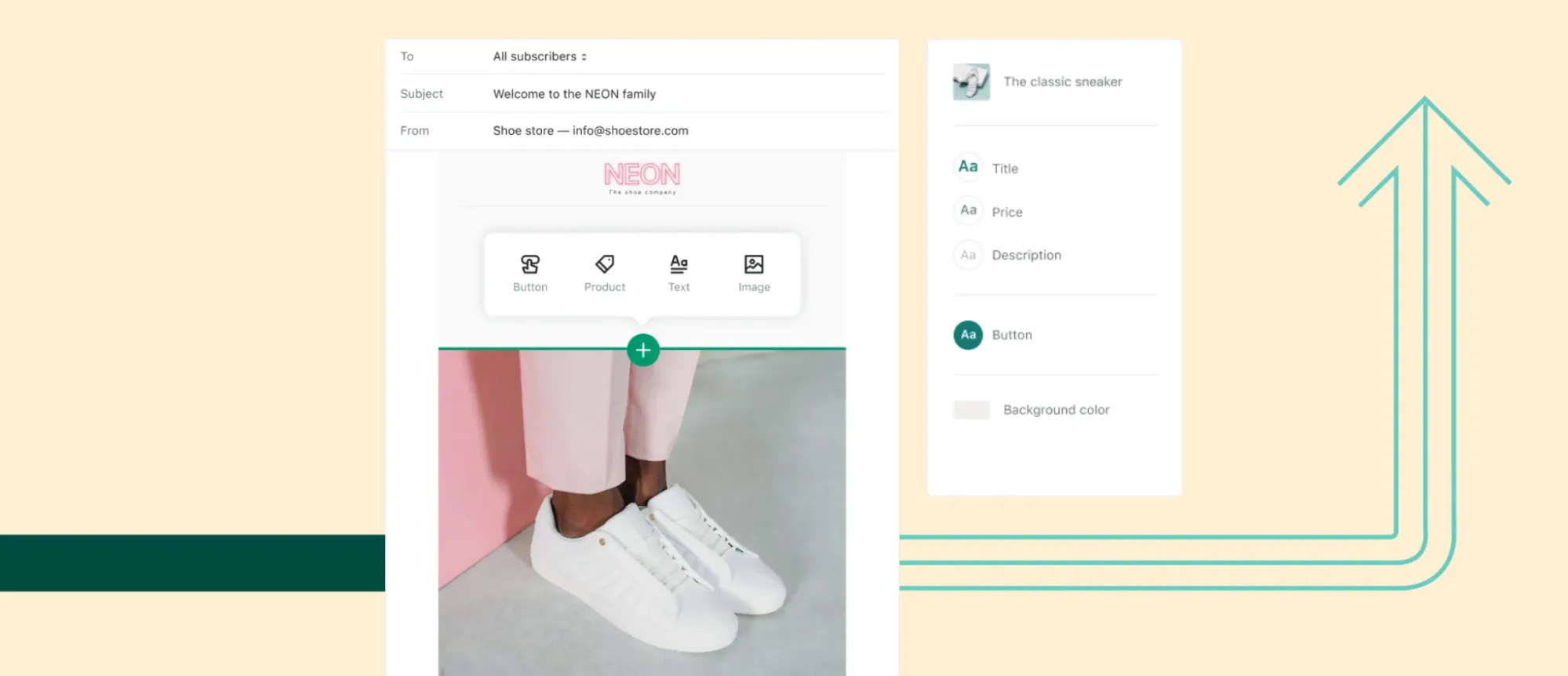
Additionally, for SEO, Shopify allows you to edit important on-page elements like meta titles, meta descriptions, URLs, and alt text for images. The platform also automatically generates a sitemap.xml and robots.txt file to help search engines crawl and index your site properly. Shopify stores are mobile-friendly by default and feature clean, optimized code, both of which are important for SEO rankings.
Besides, you can create and manage a blog directly on your Shopify store, which is a major advantage for driving organic traffic through content marketing, something Sellfy does not offer.
➥ The verdict
When comparing Sellfy vs Shopify in terms of marketing and SEO capabilities, Shopify clearly takes the lead. It offers a wide range of built-in tools and integrations that help store owners drive traffic, improve search rankings, and convert visitors into customers. Whether you're running ads, optimizing content for Google, or building long-term marketing campaigns, Shopify provides the flexibility and depth needed to grow your online business.
Design and Customization – Shopify Wins
Sellfy design and customization
In the Sellfy vs Shopify comparison, Sellfy keeps design and customization simple and minimal, making it easy for beginners to launch a clean, functional store without technical skills. While this approach is great for ease of use, it does come with some limitations for sellers who want more visual control or advanced design options.
Sellfy offers a built-in storefront with a modern layout that works well for showcasing digital products, print-on-demand items, or simple physical goods. You can customize basic elements such as:
- Store logo and favicon
- Header and button colors
- Text styles and background colors
- Homepage layout (including featured products and sections)
Besides, Sellfy also includes a small theme library, offering a handful of clean, mobile-responsive themes to help you quickly design a professional-looking storefront. While the available themes cover basic customization needs, such as changing colors, fonts, and layout sections, the selection is limited compared to Shopify’s extensive theme marketplace.
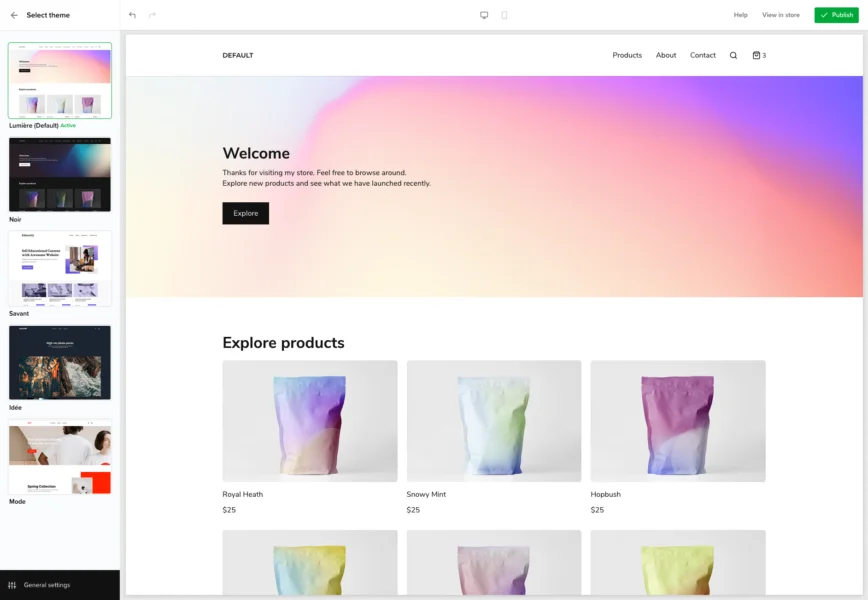
However, this platform does not support advanced code editing, which means customization options are more restricted. As a result, while the platform is great for users who want a simple and quick setup, it may feel limiting for those who need more design flexibility or a highly unique brand aesthetic.
Shopify design and customization
In terms of design flexibility and creative control, Shopify offers one of the most powerful customization systems in the eCommerce market. In the Sellfy vs Shopify comparison, Shopify clearly stands out by giving users access to a large library of professional themes and deep customization options to build a fully branded storefront.
First, this platform is packed with 200+ Shopify themes, each designed for different industries, product types, and customer experiences. These themes are mobile-optimized, modern, and come with customizable sections that allow you to edit your homepage, product pages, and other parts of your store without touching any code.

For users who want more control, Shopify also allows direct access to theme files, including HTML, CSS, and its proprietary Liquid code. This opens the door to advanced design changes and full creative freedom, perfect for businesses that want a completely unique look or need custom features tailored to their brand.
Overall, Shopify is the better choice for sellers who care about design quality and brand identity. Whether you want a ready-to-use theme or a fully custom storefront, Shopify gives you the tools to make your store look exactly how you want.
➥ The verdict
When it comes to building a professional-looking store with full control over layout and branding, Shopify is the clear winner in the Sellfy vs Shopify comparison. Shopify offers far more flexibility, visual options, and advanced customization tools, making it ideal for businesses that want a unique and polished online presence.
Apps and Integrations – Shopify Wins
Sellfy apps and integrations
When it comes to external integrations, Sellfy supports a small but useful selection. You can connect your store to Google Analytics to track traffic and performance, use Facebook Pixel and Twitter Pixel to monitor ad campaigns, and integrate with Patreon to link your audience and sell exclusive content. Sellfy also works with Zapier, which gives you the ability to connect your store with hundreds of other services like Mailchimp, Google Sheets, or Slack, though setting this up may require more effort.
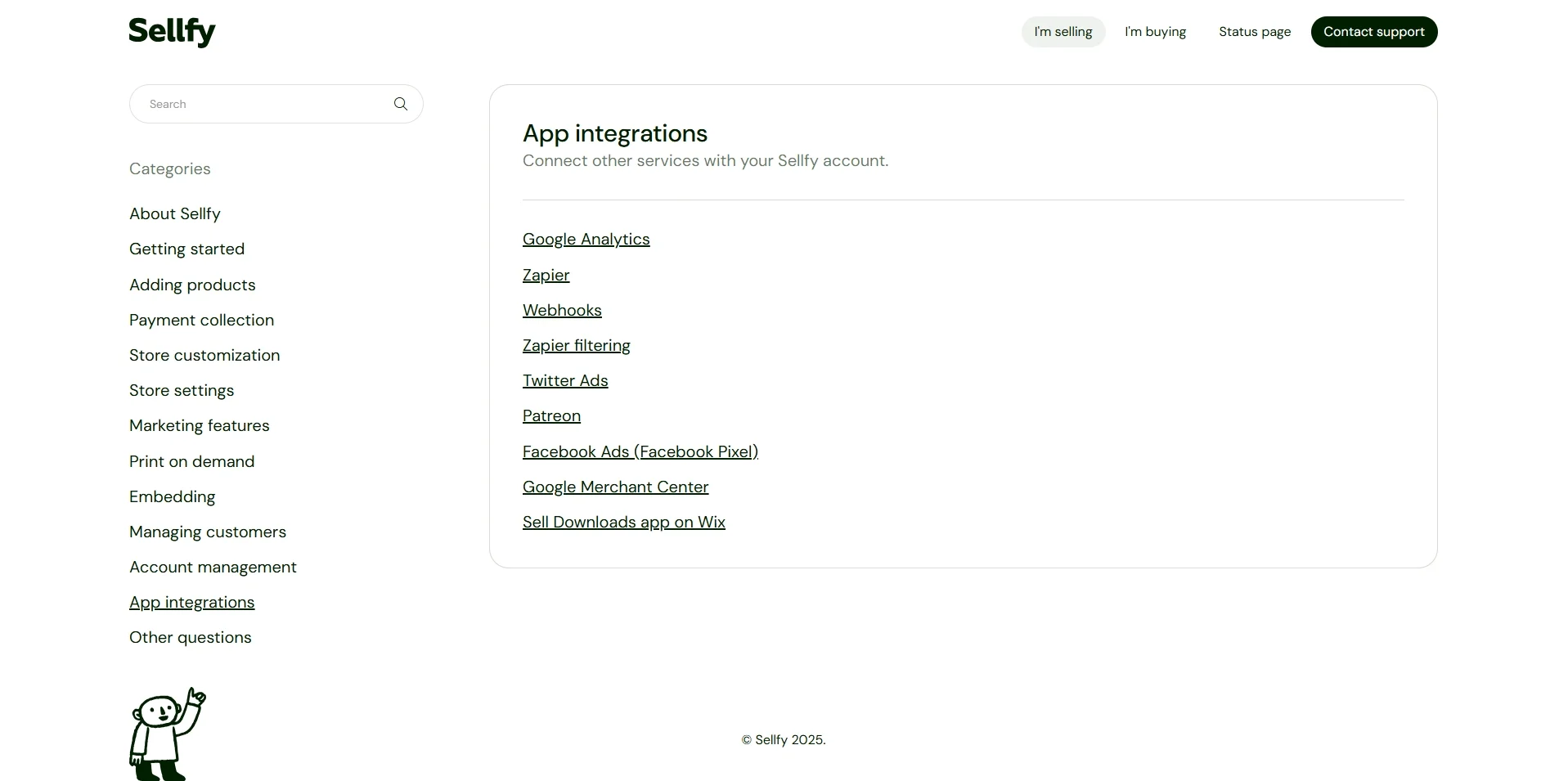
Unlike Shopify, Sellfy doesn’t offer an app store or extensive plugin library, which limits how much you can extend or customize your store through third-party tools. However, this simplicity can be a strength for creators who prefer an all-in-one platform that works out of the box without additional configuration.
If your goal is to sell with minimal complexity and manage your store from a single, easy-to-use dashboard, Sellfy’s built-in features and limited integrations provide just enough to get the job done without overwhelming you.
Shopify apps and integrations
In the Sellfy vs Shopify comparison, Shopify offers unmatched flexibility through its vast library of apps and integrations. This is one of Shopify’s greatest strengths, allowing store owners to extend and customize their store in virtually any direction as their business grows.
The Shopify App Store features over 8,000 apps, covering a wide range of needs including marketing, SEO, inventory management, shipping, customer service, analytics, and more. Most apps integrate seamlessly with your store, and many are designed specifically to work within Shopify’s admin interface. These tools can enhance your workflow, automate tasks, and improve customer experience, without the need for custom development.
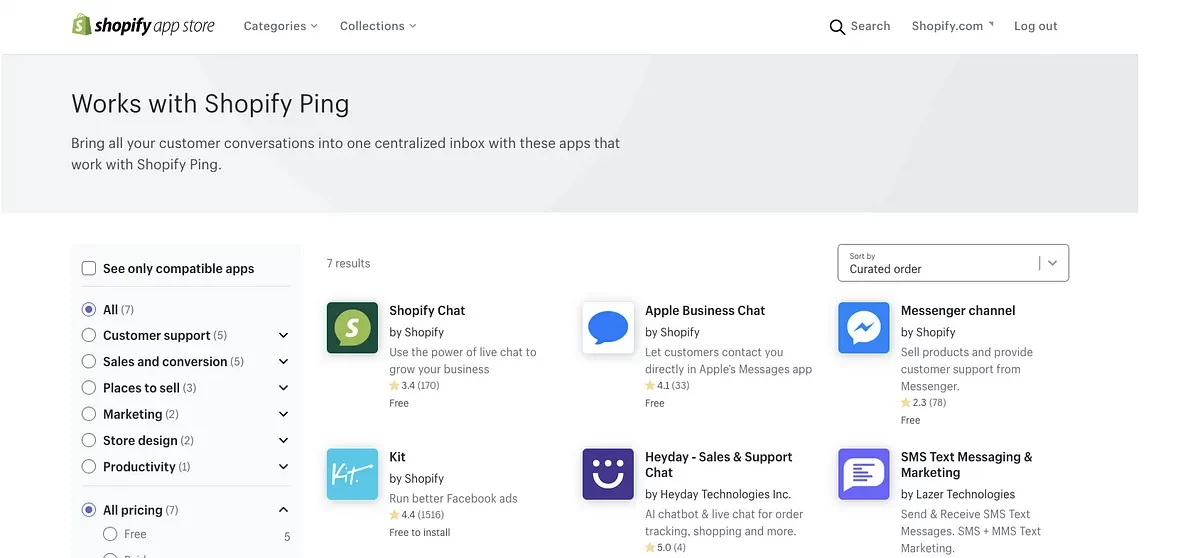
In addition to third-party apps, Shopify also offers built-in integrations and APIs for developers who want to build custom features. This gives businesses full control over their store’s functionality and the ability to scale without limitations.
Overall, Shopify is the better platform for sellers who want access to advanced tools, automation, and integrations. Whether you're running a small shop or a large-scale operation, Shopify's ecosystem gives you the freedom to build and expand your store exactly the way you want.
➥ The verdict
In the Sellfy vs Shopify comparison, Shopify is the clear winner when it comes to apps and integrations. Shopify’s extensive ecosystem gives users access to thousands of third-party tools, making it one of the most flexible and expandable eCommerce platforms available today. Whether you're looking to boost sales, improve customer experience, automate tasks, or connect with external services, Shopify has an app for nearly everything.
Customer Support – Shopify Wins
Sellfy support
Sellfy provides a straightforward and reliable support experience, especially well-suited for creators and small business owners who prefer simple, direct communication. Support is available through two main channels: the Help Center and email.
The Help Center includes a library of easy-to-follow guides, setup instructions, and FAQs that cover common topics like store setup, product management, payments, and marketing. These resources are written in plain language, making them accessible even for beginners with no technical background.
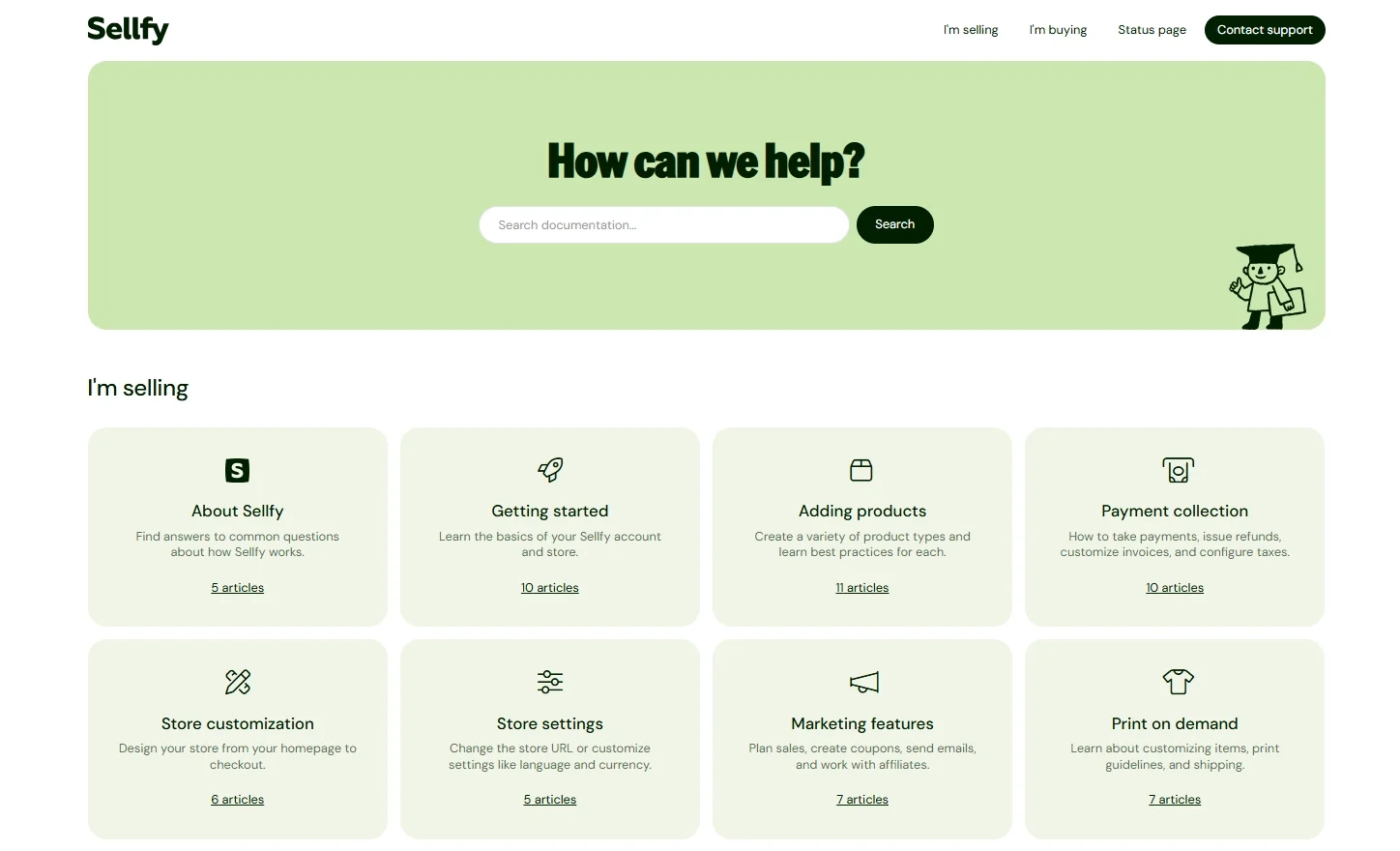
If you need additional help, you can contact Sellfy’s support team via email, and users often report quick and helpful responses. While Sellfy does not currently offer live chat or phone support, the team is known for being friendly, responsive, and focused on providing personal assistance tailored to small sellers.
Shopify support
In the meantime, Shopify provides a robust and multi-channel support system, making it one of the most accessible and well-supported eCommerce platforms available. In the Sellfy vs Shopify comparison, Shopify stands out by offering more ways for users to find help and get answers quickly.
Support is available through three primary channels: the Shopify Help Center, an active Community Forum, and direct email support. The Help Center is packed with step-by-step guides, video tutorials, and troubleshooting articles that cover everything from setting up your store to using advanced features like SEO, apps, and integrations. It’s searchable, user-friendly, and regularly updated.

The Community Forum is another valuable resource where you can connect with other Shopify users, ask questions, and find real-world solutions shared by experienced store owners. It’s a great place to get insights and advice beyond official documentation.
For more direct support, Shopify offers email assistance, and depending on your plan or location, you may also gain access to live chat or phone support. This flexibility ensures that users can choose the support method that works best for them, whether they prefer self-service resources or direct communication with Shopify’s support team.
➥ The verdict
When comparing Sellfy vs Shopify, Shopify offers more support options, giving it the edge when it comes to helping users resolve issues quickly and find answers with ease.
Security – A Tie
Sellfy security
Sellfy provides a secure and worry-free environment for creators and small business owners, handling all the technical aspects of store security behind the scenes. From the moment you launch your store, Sellfy includes built-in SSL encryption, which ensures that all data, such as customer information and payment details, is transferred securely between your site and your buyers.
In terms of payment processing, Sellfy relies on trusted gateways like PayPal and Stripe, both of which are PCI-DSS compliant. This means that your customers’ credit card information is handled according to industry-standard security protocols, without you needing to manage compliance yourself.
For digital product sellers, Sellfy adds an extra layer of protection by securely hosting your files and offering features like limited download counts and unique file delivery links. This helps prevent unauthorized sharing or piracy of your digital content.
Shopify security
On the other hand, Shopify offers enterprise-grade security features designed to protect both store owners and customers, making it one of the most secure eCommerce platforms available. As a fully hosted solution, Shopify manages all technical aspects of security, so users don’t need to worry about server maintenance, software updates, or manual configuration.
Every Shopify store comes with free SSL (Secure Sockets Layer) encryption, which protects sensitive customer data by ensuring secure connections between your website and visitors. This is especially important during checkout, where personal and payment information is exchanged.
Shopify is also Level 1 PCI DSS compliant, the highest level of security certification for handling credit card payments. This means that all transactions processed through Shopify Payments, or any of its supported third-party gateways, meet strict standards for data protection and fraud prevention.
➥ The verdict
In the Sellfy vs Shopify comparison, both platforms offer strong and reliable security measures to protect store owners and their customers. While their approaches differ slightly, each platform meets modern eCommerce standards, making this category a tie.
Our Methodology: How We Test Shopify vs Sellfy
To give you a fair and accurate comparison of Sellfy vs Shopify, we used a hands-on testing process that focuses on real-world use, practical features, and the experience of running an online store from start to finish. Our goal was to evaluate how each platform performs for different types of sellers, especially creators, entrepreneurs, and small business owners.
Here’s how we tested each platform:
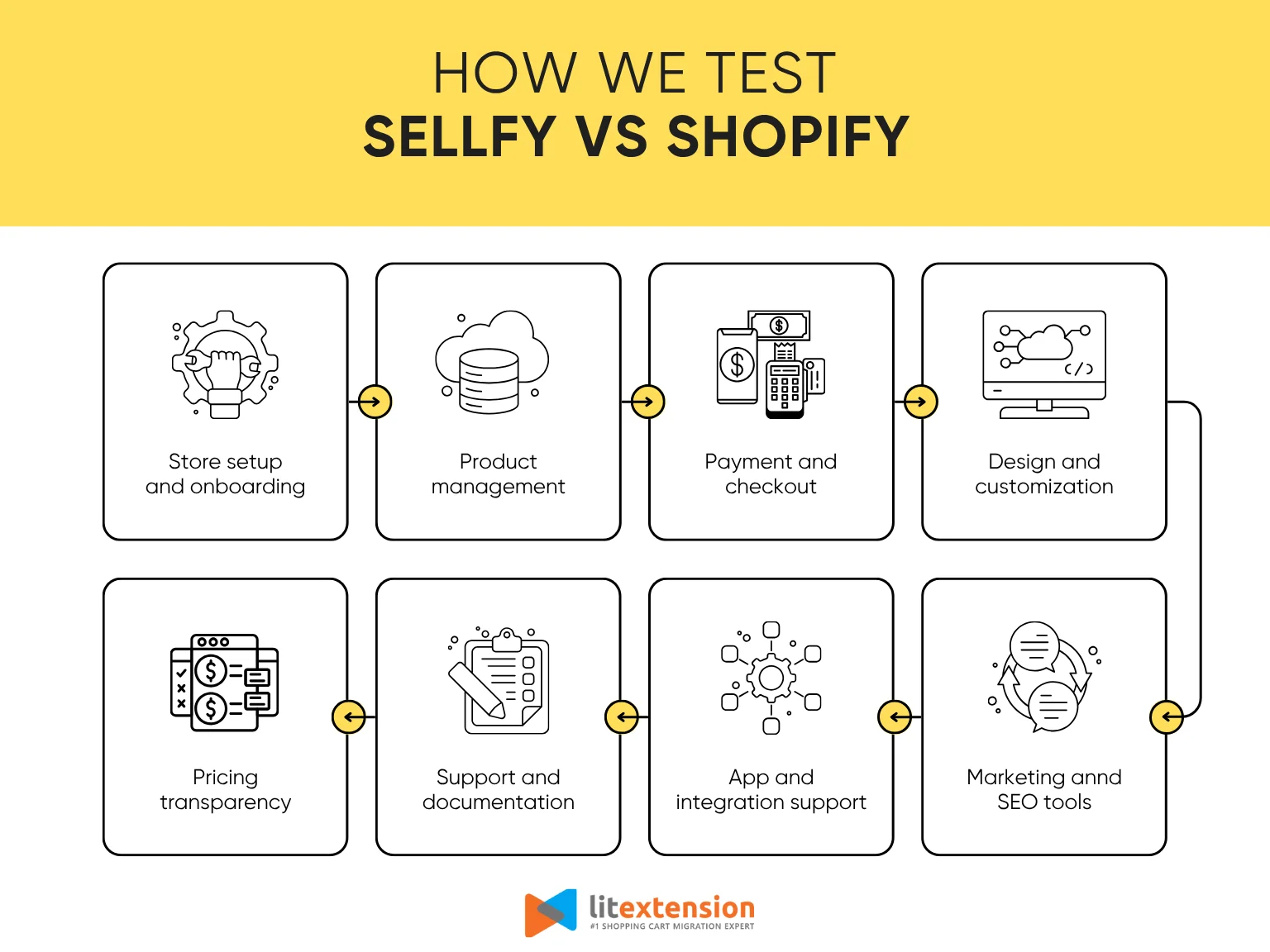
- Store setup and onboarding: We created test stores on both Sellfy and Shopify to assess how easy it is to get started. We paid close attention to account creation, dashboard layout, setup guides, and how quickly a user can launch a working storefront.
- Product management: We uploaded and configured a range of products, digital files, physical goods, and print-on-demand items to test how each platform handles product creation, inventory settings, and variants.
- Payment and checkout: We integrated payment gateways (PayPal, Stripe, and Shopify Payments) and walked through the full checkout process to evaluate speed, user flow, and customization options.
- Design and customization: We explored theme options, storefront editors, and code customization tools to see how flexible each platform is for creating a branded store.
- Marketing and SEO tools: We tested built-in marketing features like email campaigns, discount creation, SEO editing, and abandoned cart recovery. We also reviewed how each platform connects with external marketing channels.
- App and integration support: We examined the available apps, integrations, and automation tools to measure how easily each platform connects with services like Google Analytics, email platforms, and social media.
- Support and documentation: We contacted customer support, searched help centers, and reviewed available resources to assess the quality and accessibility of support.
- Pricing transparency: We compared plan features, hidden costs (like transaction fees), and the overall value of what you get at each pricing tier.
Our analysis is based on real use cases, not just feature lists. We focused on how the platforms feel and perform in actual day-to-day scenarios so you can confidently choose between Sellfy vs Shopify to find the one that fits your needs best.
Sellfy vs Shopify – FAQs
Is Shopify better than Sellfy?
It depends on your needs. Shopify is better for businesses that want full control, advanced features, and multi-channel selling. Sellfy, on the other hand, is ideal for creators who want a simple, quick setup for selling digital products or print-on-demand items without dealing with complex tools or extra apps.
Is Sellfy worth it?
Yes, Sellfy is worth it for creators, solo entrepreneurs, and small businesses looking for an easy-to-use, all-in-one platform. It’s especially great if you want to sell digital files, subscriptions, or print-on-demand products with minimal setup and low monthly costs.
Can I make money on Sellfy?
Absolutely. Many creators successfully make money on Sellfy by selling eBooks, music, videos, digital art, and merchandise. The platform has built-in tools to help you promote your products and track sales, making it a solid option for earning income online.
Who is the biggest competitor of Shopify?
Shopify’s biggest competitors include Wix eCommerce, BigCommerce, Squarespace, WooCommerce, and Sellfy, depending on the type of store you’re building. For digital-first creators, Sellfy is a strong alternative. For more customizable or large-scale stores, WooCommerce and BigCommerce are top rivals.
Final Verdict
And that brings us to the end of our Sellfy vs Shopify comparison. From our point of view, both platforms are powerful, but they serve very different types of users.
Sellfy is the better option if you’re a creator, freelancer, or small business owner who wants to sell digital products, print-on-demand items, or simple physical goods without the hassle of complicated setup or extra apps. It’s fast, easy to use, and includes everything you need to get started, all in one place. If simplicity and speed are your top priorities, Sellfy is a smart and affordable choice.
Shopify, on the other hand, is the right platform if you need advanced features, full design control, and room to scale. It's ideal for growing brands and eCommerce businesses that want to sell across multiple channels, use third-party apps, and customize every aspect of their storefront. While it comes with a steeper learning curve and higher costs, Shopify delivers unmatched flexibility and long-term growth potential.
If you want to get more tips and expert insights on Shopify and other eCommerce platforms, please check out other articles on our LitExtension website.

